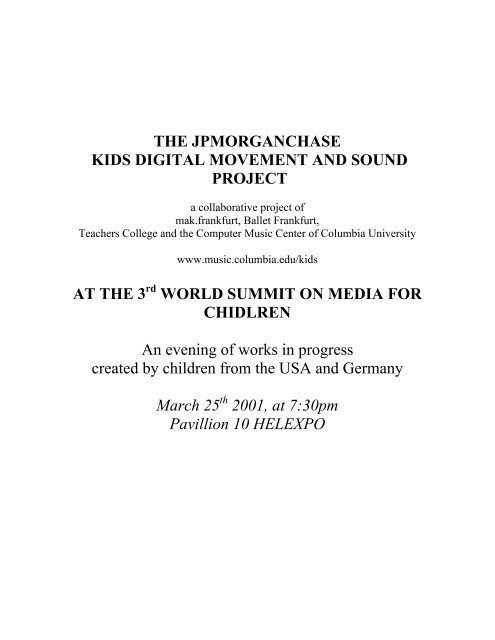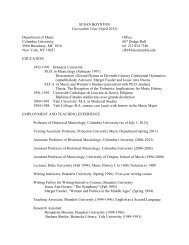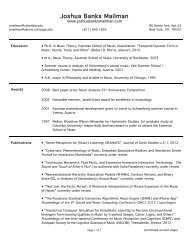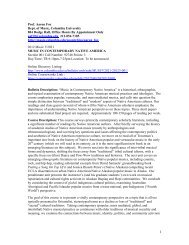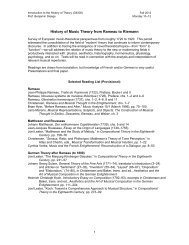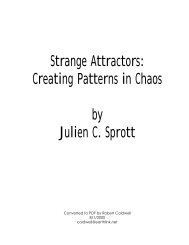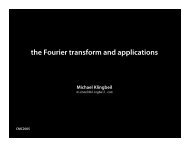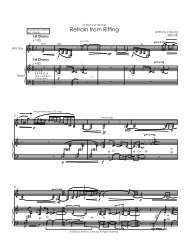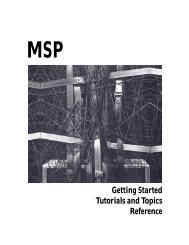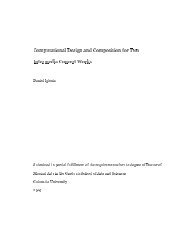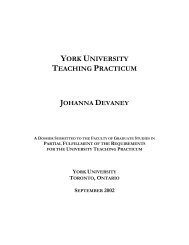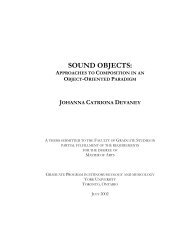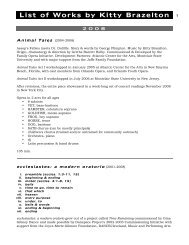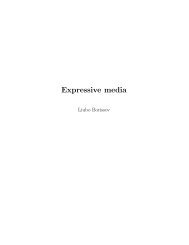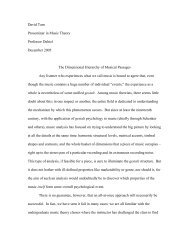The JPMorganChase Kids Digital Movement and Sound - Columbia ...
The JPMorganChase Kids Digital Movement and Sound - Columbia ...
The JPMorganChase Kids Digital Movement and Sound - Columbia ...
Create successful ePaper yourself
Turn your PDF publications into a flip-book with our unique Google optimized e-Paper software.
THE JPMORGANCHASE<br />
KIDS DIGITAL MOVEMENT AND SOUND<br />
PROJECT<br />
a collaborative project of<br />
mak.frankfurt, Ballet Frankfurt,<br />
Teachers College <strong>and</strong> the Computer Music Center of <strong>Columbia</strong> University<br />
www.music.columbia.edu/kids<br />
AT THE 3 rd WORLD SUMMIT ON MEDIA FOR<br />
CHIDLREN<br />
An evening of works in progress<br />
created by children from the USA <strong>and</strong> Germany<br />
March 25 th 2001, at 7:30pm<br />
Pavillion 10 HELEXPO
PROGRAM<br />
PART I (DIGITAL SOUND PROJECT)<br />
A Walk Through Harlem<br />
Performers: Shameena Khan, Igor Zubkov, Leila Tamari<br />
Concept, Software, Music Direction: Dan Trueman, David Birchfiled<br />
Education consultants: LaVerne Sheu, Tania Papayannopoulou<br />
<strong>Kids</strong> in <strong>Sound</strong> Space<br />
Performers: Hope Allen-Kahn, Seweryn Nehring, Mariyam Salley<br />
Concept, Direction: Douglas Repetto<br />
Software development: Douglas Repetto, Karl Ward<br />
Education consultants: Kate Hofstetter, Sun-Ho Joo<br />
R<strong>and</strong>om Number Generators<br />
Created by Wesley John-Alder<br />
Performed by Wesley John-Alder <strong>and</strong> Dan Trueman<br />
Wind Symphony<br />
For three children, three computers <strong>and</strong> three Wacom tablets<br />
Performers: Nigina Babaeva, Kamran Barros-Rashid, Mima Wellington<br />
Concept, Software, Music Direction: Thanassis Rikakis, Luke Dubois<br />
Education consultants: Victoria Young, Tania Papayannopoulou<br />
<strong>The</strong> sound project of <strong>The</strong> <strong>JPMorganChase</strong> <strong>Kids</strong> <strong>Digital</strong> <strong>Movement</strong> <strong>and</strong> <strong>Sound</strong> Project is being realized<br />
by the Computer Music Center of <strong>Columbia</strong> University with assistance from the Music Education<br />
Program of Teachers College. Project Director: Thanassis Rikakis; Principal Investigators: David<br />
Birchfield, Luke Dubois, Douglas Repetto, Thanassis Rikakis, Dan Trueman, Karl Ward; Senior<br />
Education Consultant: Lee Pogonowski; Education Co-ordinator: Tania Papayannopoulou; Education<br />
Consultants: Kate Hofstetter, Sun-Ho Joo, Tania Papayanopoulou, LaVerne Sheu, Victoria Young.<br />
<strong>The</strong> project is sponsored by <strong>JPMorganChase</strong>
"FIRST STEPS“<br />
PART II (DIGITAL MOVEMENT PROJECT)<br />
Concept James M. Bradburne, Paul Kaiser<br />
Composition Ana C. Roman<br />
in close co-operation with Valentin al Jalali, Alina Buch, Meiko Volkn<strong>and</strong>t,<br />
Jenny Frankenberg, Zarah L<strong>and</strong>es, Michael<br />
Nuske, Philip Schmoll, Sharon Sinclair, Ruth<br />
Wagner, Sascha Zimmerspitz<br />
Production Assistant Deniz Erduman<br />
LEGO Assistant Oliver Lotz<br />
<strong>Sound</strong>track Ana C. Roman, Bernhard Klein<br />
under the auspices of William Forsythe <strong>and</strong> Ballett Frankfurt<br />
dancing / robot building / programming kids:<br />
Valentin al Jalali<br />
Alina Buch<br />
Jenny Frankenberg<br />
Zarah L<strong>and</strong>es<br />
Michael Nuske<br />
Philip Schmoll<br />
Sharon Sinclair<br />
Meiko Volkn<strong>and</strong>t<br />
Ruth Wagner<br />
Sascha Zimmerspitz<br />
Supported by JP Morgan Chase<br />
mak.frankfurt<br />
Ballett Frankfurt<br />
Tonight’s concert has been produced by ALFA - AGIANIDIS AUDIOVISUAL PRODUCTIONS. Concert
PROGRAM NOTES<br />
PART I: <strong>The</strong> <strong>Digital</strong> <strong>Sound</strong> project<br />
For the sound project of the <strong>JPMorganChase</strong> <strong>Kids</strong> <strong>Digital</strong> <strong>Movement</strong> <strong>and</strong> <strong>Sound</strong> Project,<br />
children use digital technologies to record <strong>and</strong> study the sounds of their environment <strong>and</strong> their<br />
own voices. <strong>The</strong>y use the knowledge gained from this study to synthesise their own digital<br />
compositions. <strong>The</strong> children employ user-friendly tools geared to their developmental levels,<br />
but in a highly sophisticated context - a distributed or ubiquitous computing environment in<br />
which machine intelligence is not restricted to a fixed CPU <strong>and</strong> monitor, but is instead<br />
deployed in mobile formations throughout the learning environment. A large part of the<br />
control of the digital synthesis is achieved through external controllers that offer children a<br />
direct physical relationship to the elements of sound. <strong>The</strong> children work in teams <strong>and</strong> create<br />
the compositions collectively. <strong>The</strong> script (form) of the resulting compositions evolves from<br />
the soundscapes that the children experience <strong>and</strong> analyse. <strong>The</strong> children are encouraged to<br />
listen to the interaction of the sound elements of each soundscape <strong>and</strong> to incorporate this<br />
interactivity in their group compositions. In such an environment, children see that<br />
organisation can arise as a consequence of emergent structure (the unanticipated interaction of<br />
numerous interdependent elements) rather than from top-down design. Our ultimate goal is to<br />
enhance the sonic experience <strong>and</strong> connect it as directly as possible to sonic creation without<br />
the interference or mediation of external artificial processes.<br />
Tonight you will hear works in progress form the first four initiatives of this sound project:<br />
In A Walk Through Harlem <strong>The</strong> performers tell the story of a February walk through Harlem,<br />
where they recorded the sounds of the neighborhood <strong>and</strong> of various things they found. Using<br />
several unique digital instruments, they mix <strong>and</strong> modify these sounds <strong>and</strong> the sounds of their<br />
own voices, telling a sonic story. Images of their walk accompany them, in an unusual<br />
computerized slide-show that responds to their performance.<br />
<strong>Kids</strong> in (<strong>Sound</strong>)Space is a live, collaborative, interactive composition. Environmental sounds<br />
that were recorded by the group (supermarket noises, buses, the subway) are loaded into a<br />
computer. <strong>The</strong>se sounds are represented by objects that float around on the computer screen.<br />
<strong>The</strong> performers can control the motion of the sound objects via sensors they wear on their<br />
bodies. As the objects move around on the screen their qualities change: volume, spatial<br />
location, pitch, tempo <strong>and</strong> a number of other parameters can be altered for each sound. When<br />
a number of sounds are loaded at the same time, a sound environment, or space, is formed. In<br />
performance, a new piece is created every time as the performers work with the sounds in the<br />
sound space to create environments <strong>and</strong> moods that change over time.<br />
During the workshops for the creation of Wind Symphony children using filtered noise attempt<br />
at first to re-create natural noised-based sound environments: the sound of the waves, the<br />
sound of the wind, the noise of traffic, the noise of crowds, blowing wind in tubes, noise<br />
based speech syllables, noise based animal sounds. Children experiment extensively with<br />
frequency content, frequency contour <strong>and</strong> amplitude envelopes, <strong>and</strong> their<br />
interaction/integration. Through their experimentation with the creation of natural noisedbased<br />
environments, of which they have strong implicit knowledge, children familiarise<br />
themselves with digital synthesis techniques. <strong>The</strong>y are then able to use these techniques to
sounds. <strong>The</strong> final compositions (sound essays) are combinations of material created by the<br />
children during the preparatory sessions <strong>and</strong> improvisatory material created in real time<br />
during the performance.<br />
Part II: <strong>The</strong> <strong>Digital</strong> <strong>Movement</strong> project<br />
In the <strong>Movement</strong> project of the <strong>JPMorganChase</strong> <strong>Kids</strong> <strong>Digital</strong> <strong>Movement</strong> <strong>and</strong> <strong>Sound</strong> Project,<br />
the children explore the quality <strong>and</strong> nature of their own movements <strong>and</strong> how to translate these<br />
movements into LOGO procedures - operations that can be performed by the LEGO<br />
Mindstorms building system. <strong>The</strong> children then construct Mindstorms robots that combine<br />
these movements into sequences, exploiting the system's unique use of sensors to allow the<br />
robots to respond to touch, light, heat, <strong>and</strong> movement. Finally children <strong>and</strong> robots dancers<br />
participate in dance expositions. In his opening remarks during the first workshops of this<br />
project Paul Kaiser discussed the concept of the project:<br />
“<strong>The</strong> key idea behind this work is that we think not just with our heads, but with our whole<br />
bodies. Our intelligence comes not only from our mastery of logic, but also from the physical<br />
<strong>and</strong> emotional interactions we have with the world <strong>and</strong> with each other.<br />
For this project, we have not been teaching dance to the children, but rather learning with<br />
them what dance can become. Thus, we haven’t instructed them in ballet techniques, for<br />
example, but rather encouraged them to explore the full range of ordinary movements<br />
(walking, running, turning, jumping), <strong>and</strong> then let them invent new movements of their own.<br />
<strong>The</strong> same approach worked well in constructing the MindStorms Lego robots. Here again we<br />
weren’t teaching computer science to the children, but rather allowing them to discover it as<br />
they invented new ways for the robots to move.<br />
Of course, constructing <strong>and</strong> programming a robot is in fact of matter of pure physics <strong>and</strong><br />
logic, but a curious thing happens when you put these robots onto a dance stage with the<br />
children. Suddenly you start seeing the robots’ expressive qualities emerge. <strong>The</strong>y start to seem<br />
like characters. Since they’re considerably smaller than the children, they perhaps seem like<br />
their pets: but rambunctious pets, not perfectly obedient ones.<br />
When the children are dancing <strong>and</strong> interacting with the robots, what they’re really exploring is<br />
our future: for our future will involve ever more complex interactions between software <strong>and</strong><br />
people.<br />
What better place to explore that interaction than on the dance stage?“<br />
FIRST STEPS<br />
“First Steps is the first public presentation of the <strong>Movement</strong> project. For the creation of this<br />
piece we decided to invite non ballet or dance trained children to experiment with the<br />
possibilities of developing <strong>and</strong> relating their own movements with the building <strong>and</strong><br />
programming of LEGO MINDSTORMS robots; we then combine these elements.<br />
<strong>The</strong> intention of “FIRST STEPS” is to have the children interacting with the robots <strong>and</strong> to
We would like this process to be a fun period by keeping the spontaneity of the children’s<br />
movement alive as well as the spirit of art, learning <strong>and</strong> playing”.<br />
(Ana C. Roman)<br />
Biographical notes of performers <strong>and</strong> creators<br />
Part I: <strong>The</strong> <strong>Sound</strong> Project<br />
Wesley John-Alder was born in New York in the United States of America, but he has since<br />
moved. He enjoys listening to music <strong>and</strong> riding his bicycle. He currently attends high school,<br />
<strong>and</strong> he plans to attend college.<br />
Hello, my name is Nigina Babaeva. I was born in Dushanbe, Tajikistan. But now I live in<br />
New York City, I have been living here since I was six years old.<br />
R. Luke DuBois is a composer, programmer, <strong>and</strong> performer living in New York City. He is<br />
currently finishing his DMA degree at <strong>Columbia</strong> University, <strong>and</strong> teaches interactive computer<br />
music at the <strong>Columbia</strong>'s Computer Music Center <strong>and</strong> at New York University. His music<br />
with his b<strong>and</strong>, the Freight Elevator Quartet, is available on Caipirinha/Sire, Liquid Sky, <strong>and</strong><br />
Cycling'74 Music.<br />
Kate Hofstetter is originally from NH where she graduated from Plymouth State College <strong>and</strong><br />
taught elementary school music. She came to NYC 5 years ago, <strong>and</strong> is currently in the<br />
Master of Music Degree program at Teachers College, as well as an employee of <strong>The</strong><br />
Computer Music Center.<br />
Sun Joo received her BM from Oberlin Conservatory <strong>and</strong> her MM from Yale University<br />
School of Music. She was invited as a guest artists in the summer of 1999 to give master<br />
classes in Bogota <strong>Columbia</strong>, University of Narinro while touring through South America for<br />
Concerts. She is currently pursuing her doctorate degree in Music Education at Teachers<br />
College <strong>Columbia</strong> University.<br />
My name is Shameena Khan. I go to Computer School Two. I love to play soccer with my<br />
friends. I also love to talk on AOL with my friend Diamond.<br />
Seweryn Nehring was born in Pol<strong>and</strong> <strong>and</strong> he now lives in New York City. He is in 6th grade<br />
at the Computer School. He likes to play soccer <strong>and</strong> spends most of his time in front of the<br />
computer.<br />
Tania Papayannopoulou was born in Athens,Greece. She came to New York five years ago<br />
where she completed her Bachelor Degree in Music Education <strong>and</strong> Performance in piano.<br />
She is currently working on her Master of Education in Music at Teachers College <strong>Columbia</strong><br />
University, as well as teaching music. She is looking forward to completing her Doctorate of<br />
Education in the near future.<br />
My name is Kamran Barros-Rashid. I am from New York City. I have one older sister <strong>and</strong> I<br />
like to play soccer <strong>and</strong> football.
Douglas Repetto is an artist, performer <strong>and</strong> educator. When not building electronic sculptures<br />
or writing realtime music performance software he spends lots of time talking to plants.<br />
Douglas works at the <strong>Columbia</strong> University Computer Music Center, where he maintains the<br />
computer networks, builds human/machine interfaces <strong>and</strong> teaches a variety of topics.<br />
Thanassis Rikakis is the Associate Director of the Computer Music Center of <strong>Columbia</strong><br />
University. Thanassis composes acoustic <strong>and</strong> computer works. His research concentrates on<br />
music perception <strong>and</strong> psychoacoustics with special emphasis on the use of microtones in<br />
western compositions <strong>and</strong> medical applications of music (www.music.columbia.edu/~than)<br />
Mariyam Salley was born in New York City. She goes to school at the Computer School<br />
where she is a 6th grader. She likes reading, watching TV <strong>and</strong> listening to music.<br />
Laverne Sheu is a graduate student at Teachers College <strong>Columbia</strong> University pursuing her<br />
Masters in Music Education. Originally from the San Francisco Bay Area, she achieved her<br />
Bachelors of Arts at the University of California Berkely. Though she is a professional<br />
cellist, she ultimately aspires to teach general music in a classroom setting.<br />
I, Leila Tamari, like to write my own creative writing. I like school even though it's a new<br />
experience in Middle School. <strong>The</strong>re is a lot more homework <strong>and</strong> you get pushed around by<br />
Seventh <strong>and</strong> Eighth Graders. I am also interested in composing music <strong>and</strong> playing with it.<br />
When I grow up, I hope to be an ecologist, a zoologist, <strong>and</strong> a writer. Maybe even in my<br />
spare time i'll be a music composer. And to be honest, I'm one crazy person!<br />
Dan Trueman composes <strong>and</strong> plays various violins, including the Norwegian Hardanger fiddle<br />
<strong>and</strong> the 6-string electric violin. He currently works at the <strong>Columbia</strong> Computer Music Center.<br />
Karl Ward is a <strong>Columbia</strong> College senior studying English <strong>and</strong> working at the Computer<br />
Music Center. Karl spends most of his time dabbling in literature, physics, computer science,<br />
civil libertarian politics, <strong>and</strong> music.<br />
My name is Mima Wellington. My school is the Computer School <strong>and</strong> I like learning a lot. I<br />
also love to travel to foreign areas.<br />
Victoria Young holds a BA (Honors) from Princeton University <strong>and</strong> is an M.A. c<strong>and</strong>idate at<br />
<strong>Columbia</strong> University Teachers College for music <strong>and</strong> music education. A former student of<br />
the Julliard Pre-College, Victoria has given solorecitals at Carnegie Halls’s Weill Recital<br />
Hall, Julliard Paul Hall, <strong>and</strong> Princeton University where she also served as concertmaster of<br />
the University Orchestra.<br />
Igor Zybkov is going to Computer School One. Born in 1989, May 4. My best friend is Joshua<br />
Rim.<br />
Part II: <strong>The</strong> <strong>Movement</strong> project<br />
James Bradburne is a British-Canadian architect, designer <strong>and</strong> museum specialist, who has<br />
designed World's Fair pavilions, science centres, <strong>and</strong> international art exhibitions. Educated<br />
in Canada, <strong>and</strong> Engl<strong>and</strong>, he ha developed numerous exhibitions, research projects <strong>and</strong><br />
symposia for UNESCO,UNICEF, national governments, private foundations, <strong>and</strong> museums<br />
worldwide during the course of the past fifteen years. He lectures internationally about new
approaches to informal learning, <strong>and</strong> has published extensively. As of January 1st, 1999, he<br />
has been Director of the Museum fur Angew<strong>and</strong>te Kunst in Frankfurt am Main.<br />
Paul Kaiser is a digital artist who created the virtual dances H<strong>and</strong>-drawn Spaces (1998) <strong>and</strong><br />
BIPED (1999), both with Merce Cunningham <strong>and</strong> Shelley Eshkar, <strong>and</strong> Ghostcatching (1999),<br />
with Bill T. Jones <strong>and</strong> Shelley Eshkar. Kaiser teaches virtual filmmaking at Wesleyan<br />
University, <strong>and</strong> lives in New York City with his wife <strong>and</strong> two daughters.<br />
Ana Catalina Roman was born in Madrid, Spain, trained at the Real Conservatorio Superior<br />
de Espana with Ana Lazaro <strong>and</strong> danced in the “Joven Ballett Concierto” under her direction.<br />
She finished her training in the John Cranko School in Stuttgart with Heinz Clauss <strong>and</strong> Jean<br />
Wallis. She danced with Gelsenkirchen Ballett under the direction of Bernd Schindowsky.<br />
She joined the Ballett Frankfurt in 1980 at first under the direction of Egon Madsen <strong>and</strong> since<br />
1984 under the direction of William Forsythe. She danced as a soloist in most of the Ballett<br />
Frankfurt Productions <strong>and</strong> collaborated on many. In the last years she has also assisted<br />
William Forsythe on various pieces. She has choreographed six short pieces herself <strong>and</strong> is a<br />
Ballett Teacher. At present she is studying Film Drawing Animation.<br />
Museum für Angew<strong>and</strong>te Kunst Frankfurt am Main (mak.frankfurt) was founded in 1877 by<br />
the Middle German H<strong>and</strong>icrafts Society as part of a broad concern for the education of<br />
craftworkers <strong>and</strong> improving the quality of industrial production. <strong>The</strong> Society's collection was<br />
taken over by the City of Frankfurt in 1921, <strong>and</strong>, after the destruction of its premises during<br />
the war, was kept in storage until finally being installed in Villa Metzler (1803) in 1966. <strong>The</strong><br />
present museum building was designed by the American architect Richard Meier to<br />
incorporate the Villa Metzler, <strong>and</strong> was completed in 1985. <strong>The</strong> Museum is home to<br />
internationally-renowned collections of European, East Asian, <strong>and</strong> Middle Eastern applied<br />
arts, as well as a special collection of the arts of the book. <strong>The</strong> museum was relaunched in<br />
May 2000 with a new name, a new identity, new visitor facilities, <strong>and</strong> newly-installed<br />
collections. <strong>The</strong> museum now hosts a permanent collection of Design, including websites<br />
<strong>and</strong> computer games. <strong>The</strong>re is wireless internet access throughout the museum, as well as a<br />
Learning Laboratory, a Computer Lab, <strong>and</strong> a Lab in which young people test computer<br />
games. <strong>The</strong> museum is now open daily until 20.00 <strong>and</strong> hosts wine tastings, fashions shows,<br />
<strong>and</strong> Internet auctions . In addition, it has opened a new bistro/restaurant open until midnight,<br />
<strong>and</strong> a new design shop featuring objects from the museum’s Design


